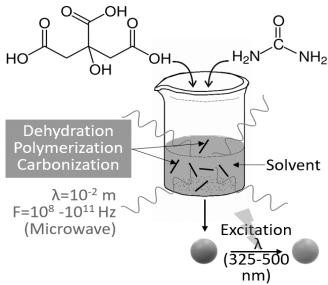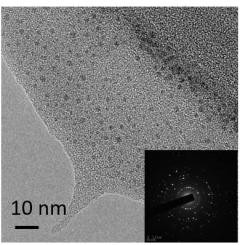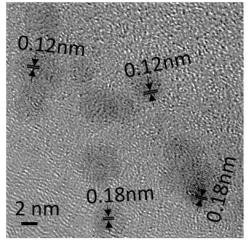This invention describes a method for fabricating carbon quantum dots-based dye sensitized solar cells (QDSC). The method further comprises forming photo anode using a mesoporous wide band-gap semiconductor patterned layer on a substrate electrode, the photo-anode comprises carbon quantum dots. The photo anode is anchored with a layer of photo-sensitizer and absorbing counter electrode to the photo-anode to provide electrolyte between the photo anode and the counter electrode to form the QDSC.
Figure (1) A schematic illustrating a synthesis process of NCQD for fabricating carbon quantum dots-based dye sensitized solar cells; (2) Transmission Electron Microscopy (TEM) micrograph of the NCQD exhibits Selected Area (electron) Diffraction 15 (SAED) pattern; (3) High-resolution TEM (HRTEM) image of the NCQD exhibiting various inter planar distance in the NCQD used for fabricating the carbon quantum dots based dye sensitized solar cells
Current dye-sensitized solar cells (DSSCs) face challenges such as limited light absorption range, low photoconversion efficiency, and high recombination rates due to inefficient electron transfer between dye, semiconductor, and electrolyte components. The use of traditional dyes limits spectral absorption, and water-based solvents increase recombination, reducing cell efficiency.
- Use of Nitrogen-Doped Carbon Quantum Dots (NCQDs): The technology utilizes abundant, non-toxic carbon-based quantum dots doped with nitrogen, offering a sustainable and environmentally friendly alternative to traditional metal-based dyes.
- Enhanced Photoconversion Efficiency: Incorporation of NCQDs as co-active or sole sensitizers significantly improves photocurrent density and overall solar cell efficiency, achieving up to 8.75% efficiency.
- Versatile Sensitizer Configurations: The technology supports multiple configurations including NCQDs combined with TiO2, NCQDs as co-sensitizers with N719 dye, or NCQDs alone, providing flexibility in device design.
- Microwave-Assisted Synthesis: Employs a green, rapid, and scalable microwave synthesis process for producing NCQDs with controlled size and properties, reducing manufacturing time and cost.
- Strong Anchoring via Carboxylic Groups: NCQDs are functionalized to attach firmly onto the TiO2 photoanode surface, improving charge transfer efficiency and device stability.
- Cost-Effective and Scalable Manufacturing: The use of abundant materials and simple synthesis methods enables cost reduction and ease of scaling up for large-scale solar cell production.
The prototype consists of dye-sensitized solar cells (DSSCs) fabricated by integrating nitrogen-doped carbon quantum dots (NCQDs) with TiO2 (P25) or N719 dye in multiple configurations, including NCQDs as co-active with TiO2, co-sensitizers with N719, or as the sole sensitizer. These devices demonstrate enhanced photocurrent density of 18.13 mA/cm2 and photoconversion efficiency up to 8.75% when NCQDs are incorporated. The design features a mesoporous TiO2 photoanode sensitized with NCQDs anchored through carboxylic groups, paired with a counter electrode and electrolyte to complete the solar cell assembly. The NCQDs are synthesized via microwave-assisted methods, with careful control of reaction time and solvent choice to optimize their optical and electronic properties.
The technology is at demonstration and/or validation in lab environment stage.
4
This technology paves the way for more efficient, affordable, and eco-friendly solar energy harvesting by utilizing abundant, non-toxic carbon-based quantum dots instead of costly and rare metal-based dyes. By improving solar cell performance and reducing manufacturing costs through scalable green synthesis methods like microwave synthesis, it supports wider adoption of clean energy solutions. This advancement enhances the feasibility of solar power in diverse applications, helping to reduce reliance on fossil fuels and contributing to a sustainable energy future.
- Renewable energy sector, specifically solar photovoltaic technology
- Dye-sensitized solar cell (DSSC) manufacturing and research
- Nanomaterials and quantum dot-based optoelectronics
- Energy harvesting devices for portable and large-scale solar panels
- Environmental technology focused on sustainable materials and green energy
Geography of IP
Type of IP
202221008545
419943



